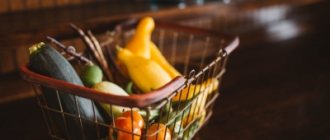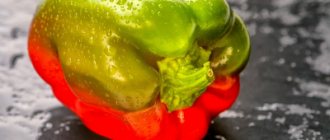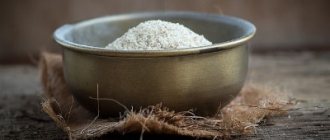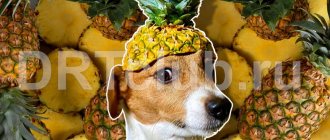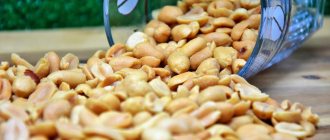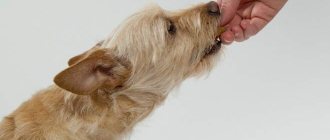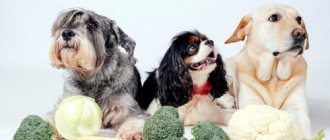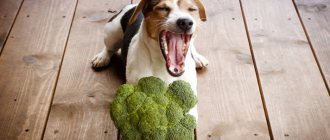Dog breeders are often concerned about the balanced nutrition of their pets, because four-legged pets cannot feed themselves. There are heated and endless debates about the safety of feeding animals with fresh and boiled vegetables.
ordinary white cabbage causes doubts and fear ! Let's try to figure out whether this vegetable is really necessary and how true are the fears of careful owners who guard the health of their charges.
Animal's need for vegetables
To understand a domestic animal, you need to remember its distant ancestors: wolves, jackals and foxes. “Relatives” living in nature eat meat in the event of a good hunt. Typically, predators feed on plants, eggs, small rodents, amphibians and insects.
Pasture includes fruits, berries, roots, algae, herbs, bark and even mushrooms . This indicates a genetically inherent need for plant foods in the daily diet of a four-legged friend.
Vegetables that are controversial about their benefits or harm
There are vegetables that are not strictly prohibited. However, some of them are not beneficial enough, while others are not suitable for all dogs and can cause serious harm to the pet's health if due care is not taken.
Beet
This root vegetable is rich in potassium, antioxidants and folic acid. But this is a rather allergic vegetable.
If your dog is not allergic to beets, then a small amount will only be beneficial. Eating this vegetable will give a rich and bright color to dogs with red hair. In large quantities it can cause diarrhea.
Tomatoes
Tomatoes are generally included in the list of foods not recommended for dogs because, when fed in large quantities, they can cause stomach upset, cardiac dysfunction, rapid heartbeat, muscle weakness and tremors.
However, in small quantities, it is quite a healthy vegetable. Tomatoes serve as an excellent prevention of plaque formation. They are a strong antioxidant and a good remedy for fighting inflammatory processes.
Therefore, if the dog is not allergic to tomatoes, then it is recommended to include them in the four-legged diet in reasonable quantities. Fresh ripe tomatoes are the safest.
Broccoli
Some dog breeders have undeservedly included this vegetable in the list of not recommended. This was done because this variety of cabbage contains a substance called isocyanate, which is a toxin for dogs and can cause the death of the animal.
However, in order for this vegetable to do any harm, you need to give it to your pet daily in large quantities and as only the only vegetable.
Broccoli is rich in microelements and vitamins C and K. And in terms of vitamin A content, it surpasses all other cabbage plants. All valuable vitamins are preserved much longer in frozen cabbage. Therefore, I safely buy frozen broccoli and, from time to time, add it to my Jack’s food along with other vegetables.
Cabbage
White cabbage is an excellent source of sulfur, calcium, potassium, phosphorus, beta-carotene and vitamins A, B and C. And, I must say, many pets love it very much because they can crunch and chew hard pieces of leaves.
But fresh cabbage is not recommended for dogs in large quantities, as it causes gas formation, stomach turmoil and intestinal pain. But with boiled or stewed cabbage, you can pamper your pet from time to time.
Eggplant
This vegetable is rich in fiber, phosphorus, iron and carotene. However, it is not recommended to be given to animals with kidney disease. Eggplant can cause allergies in some dogs. Recommended for feeding baked or slightly stewed, but not on an ongoing basis.
White cabbage
IMPORTANT! A healthy, active dog, not restricted in its diet by a veterinarian, can and should eat cabbage!
The main part of the menu of a domesticated predator consists of 70-80% products rich in animal protein. Vegetables and grains saturated with natural vitamins and microelements occupy the remaining, but no less important place .
Benefit
Cabbage contains natural antioxidants, vitamins and fiber necessary for digestion, is a source of calcium, sulfur, potassium, phosphorus, beta-carotene and vitamins A, B and C, prevents the development of cancer and improves the condition of the skin and coat.
Dog owners tell how their pets enjoy eating cabbage . There is information that many dogs like to gnaw on heads of cabbage, hard parts of leaves, and play with stalks. After such a feast, undigested pieces appear in the feces of the mischievous people. No need to worry about this.
Vegetative food is poorly absorbed by the dog's body. Their digestive system lacks enzymes involved in the breakdown of cellulose. Question: why feed an animal something it cannot digest?
The content of cabbage in your pet’s diet is very important! The affordable vegetable is rich in vitamins and microelements, so necessary for a living creature, and takes an active part in digestion.
Why is a plant-based diet so important?
Carnivores are not able to extract energy from complex carbohydrates - this is a feature of herbivores . Coarse fiber from raw vegetables and bran is a nutrient medium for the development and formation of healthy microflora, stimulates the functioning of the predator’s intestines and removes excess cholesterol.
Cabbage is a source of slow carbohydrates and dietary fiber, which create healthy microflora and help the animal digest meat.
IMPORTANT! Excluding vegetables from the diet leads to a decrease in the number of beneficial bacteria in the microenvironment of the gastrointestinal tract and their replacement by pathogenic colonies of E. coli and yeast, which cause dysbacteriosis.
Which vegetables are not recommended for dogs?
We already know what vegetables can be given to a dog. And there are vegetables that you shouldn’t feed your pets.
Broccoli
Contains isothiocyanate. In small doses it is harmless, but if abused, it can cause health problems. If you don't want to risk it, replace the broccoli with another vegetable.
Tomatoes
A vegetable that can be given raw, but only occasionally, as a treat. Eating large quantities of tomatoes can cause heart rhythm disturbances, diarrhea, and allergies.
Corn
It is not absorbed by the dog’s body, which means it is completely useless. Occasionally, a handful of grains can be offered to your pet, but no more.
Eggplant
What vegetables can dogs cook? Eggplant. They are given exclusively heat-treated and in limited portions. If your pet has unhealthy kidneys, avoid eggplants altogether. Also, when adding eggplants to your food, make sure that you do not develop an allergy.
Asparagus
Raw green beans are a difficult to digest product. When boiled, it becomes “empty” and useless food. Opt for a more valuable vegetable.
How often and in what quantities?
But you shouldn’t fanatically put your animal on a plant-based diet. After introducing your pet to this garden gift, it should be introduced into the diet gradually and in small portions . If you like the treat, then it should be consumed fresh periodically and in small quantities.
According to breeders, among their four-legged friends there are real gourmets who love to eat cabbage raw. There is no need to deprive such a dog of the desired treat - the body signals a lack of vitamins . You just have to limit your tummy from overeating, which applies to any product, even a very healthy one.
Features of the digestive system
To understand what components of the diet and in what quantities are needed by representatives of the canine family, you should study the features of the digestion process.
Interesting Facts:
- Compared to humans, the microflora of dogs is less saturated - 10,000 bacteria per 1 g of tract, while in humans this figure is 10,000,000 per 1 g.
- The number of teeth is 42. The main function is tearing and grinding food, not chewing.
- The number of taste buds is 1,700. For comparison, a person has 9,000.
- Relative to the body, the dog's stomach is 10 times larger than that of herbivores. When full, it contains 10 times more hydrochloric acid than in the human stomach.
- Small colon. At the same time, it takes up to 1 day to process meat, while for herbivores the digestive process takes up to 5 days.
- Dogs' bodies do not have the enzymes necessary to break down plant fiber.
Dogs' bodies are not equipped to produce enzymes to digest plant fiber.
Based on the above, the following conclusions can be drawn. Vegetables and greens are partially absorbed by the body. The state of the intestinal microflora also indicates limited digestive capabilities. The size of the stomach indicates the ability to absorb large volumes of food. The structure of the jaw, the length of the colon and the characteristics of the production of hydrochloric acid indicate the need to eat easily digestible roughage. The taste of food, based on a small number of receptors, does not play an important role in the absorption of food.
Despite the above facts and the absence of a multi-chambered stomach, dogs need vegetables in small quantities
Wild past
Biologically, a dog is a predator. By analogy with her ancestors, she prefers meat.
However, in addition to food of animal origin, the wolf does not disdain plant foods. It feeds on herbs, berries, plant roots, herbivore excrement and insects. At the genetic level, this indicates a need for plant foods.
The basis of the wolf diet is meat
Enzyme fence
When eating herbivores, wolves first of all paid attention to the stomach. There is a version that this behavior is due to the need to receive the digested plant food found in it. Due to the lack of the necessary enzymes in the canine body for its processing, this hypothesis seems logical.
However, this did not solve the problem of lack of enzymes, since the rumen does not contain them. In addition, the wolves’ body is not able to use the remnants of foreign enzymes. These facts refute the thesis of enzyme sampling.
It is more logical to assume that wolves eat semi-digested plant food in order to improve the processing of meat in the body. Therefore, veterinarian nutritionists recommend that when feeding tripe to dogs, do not wash away the green silage from it.
A dog's digestion is not designed to process grass shoots.
Is there any harm?
Fresh cabbage eaten in large quantities can negatively affect your health . Usually the glutton ends up with gas formation, seething in the belly, bloating and strong winds. Sometimes this is accompanied by discomfort in the intestines.
Dogs suffering from diseases of the gastrointestinal tract and thyroid gland should be given cabbage according to the recommendation of a doctor, in doses, after appropriate treatment. The owner must remember that even in small quantities the plant contains a natural component called thiocyanate , which in large doses suppresses the thyroid gland and leads to hypothyroidism.
If a dog cannot imagine life without a tasty treat and wants to eat it often and a lot, then it is better to boil the vegetable before consumption in order to neutralize the unwanted substance.
Reasons why you can't
Cases of individual intolerance to white cabbage in dogs are quite rare. Small species are characterized by difficult digestion of plant foods and difficult gas separation. In this case, the cabbage should be steamed, stewed, boiled and served in small portions .
Attention to the animal's diet is required for certain forms of diseases and allergies. Typically, such pets are under medical supervision and strict dietary control.
ATTENTION! Add new products gradually, observing the dog's reaction.
What to do if your pet has eaten too much and feels bad?
In case of overeating, and such cases are unique and isolated, some symptoms may occur :
- Difficulty in digestion caused by excessive consumption of food;
- Excessive gas formation, accompanied by bloating and pain in the intestines;
- The animal is inactive, lies for a long time, stretches unnaturally, whines;
- He does not allow himself to be examined due to pain in the peritoneal area.
The owner should contact a veterinarian, not self-medicate and not give any medications , blurring the overall picture of the condition. At the appointment, describe in detail the dog’s behavior from the moment the illness began, trying to indicate as accurately as possible the time and cause of the deterioration in health.
Which vegetables should you completely avoid?
There are vegetables that absolutely should not be given to dogs. These include:
- Avocado – contains persin, a toxin that causes vomiting and distress in dogs. It is a toxin for animals.
- Mushrooms are too heavy and unnatural a product for a dog’s body. Causes serious poisoning.
- Onions – causes stomach pain, vomiting, diarrhea.
- Garlic is poisonous in large quantities. May cause vomiting, stomach upset, anemia, poisoning.
- Legumes are not digestible and cause bloating and discomfort in the dog.
- Any salty, sour, pickled vegetables. They contain spices, vinegar and salt in excess, which is harmful to dogs.
Watch what your dog eats. Do not leave harmful products in easily accessible places, because only you are responsible for the health of your pet!
Puppies, pregnant or lactating
Feeding a mother before and after childbirth depends entirely on her appetite, her condition and food preferences. Usually it is milk porridge and meat puree with vegetables.
Boiled or stewed cabbage with meat is an important component in the presence of calcium, vitamin C and other necessary elements. You can forget about the vegetable in its raw form, because babies get absolutely everything that their mother eats, and excess gas formation is extremely undesirable for her, either “before” or “after”.
Attention! It is important to accustom animals to natural feeding in a timely manner. After getting acquainted with milk, cereals and meat supplements, vegetable soup appears on the children's menu, to which a pinch of finely chopped raw cabbage is added with boiled cereals and finely chopped steamed meat.
Puppy meal options:
- vegetable soups;
- porridge in vegetable broth with meat and cabbage;
- separately cooked meat with vegetables.
Chop or finely grate all plant foods, add a little butter or sour cream.
An irreplaceable vitamin supplement in the form of a mixture is also served as an independent dish. When the puppies grow up and get stronger, the diet includes a salad of fresh vegetables with vegetable oil.
Contraindications
Despite its beneficial effect on the gastrointestinal tract, cabbage is given with caution if you have a tendency to flatulence and frequent stomach upsets. Contraindications: enteritis, gastritis, pancreatitis, because the pain increases. Excessive consumption of raw vegetables, even in a healthy dog, will cause increased gas formation. To help the animal, you need to give Espumisan or Smecta. If this phenomenon occurs regularly after eating raw cabbage, it will require heat treatment.
Thyroid hormone deficiency is another contraindication caused by the presence of thiocyanate, which suppresses the functioning of this important endocrine organ. Overeating cabbage causes the development of hypothyroidism in a healthy animal.
Due to the possibility of bloating and indigestion, the consumption of cabbage leaves is limited to pregnant and lactating females. It is better to replace cabbage with dietary varieties.
The benefits of the stalk are questionable. Dogs love to chew it, but it should not be abused due to the increased accumulation of harmful substances coming from the soil and pesticides that are used to treat the crop during cultivation.
Raw, boiled, stewed or pickled?
Precisely because a dog is not able to completely digest cabbage, this product, as the main source of fiber, is involved in the processes of feces formation, intestinal motility and maintaining favorable microflora. Question: in what form should I give it?
It makes no difference how you offer vegetables - finely chop them or puree them. The main thing is to focus on health characteristics, veterinarian advice, the preferences of the dog, the state of the digestive system and teeth.
For better absorption of vitamins, the product is crushed or ground. Can be boiled or boiled by adding other ingredients.
Feed alternation
- grind in a blender;
- grate;
- cut in small pieces;
- cut into cubes or cubes;
The dog happily eats diced vegetables, independently chopping them to a size that is convenient for him.
Chewing raw cabbage helps prevent plaque formation and freshens breath .
This form of feeding is not suitable for puppies and adult pets transitioning to natural nutrition from dry food. Children are not able to chew food, and the animal, not accustomed to innovations, chooses meat, leaving pieces of vegetables untouched.
Vegetables can be given raw, boiled or baked . Many of them contain beta-carotene, which is digestible only when stewed with a small amount of animal fat, sour cream or kefir. These include: carrots, cabbage, tomatoes, eggplants, turnips and beets.
TIP: Does your dog enjoy fresh cabbage with pleasure and without consequences? To preserve valuable properties, there is no need to heat treat the product.
If desired and possible, you can pamper your little animal with a delicious vegetable casserole :
Ingredients vary according to pet's preferences:
- carrot;
- pumpkin;
- zucchini;
- cabbage;
- tomato;
- a raw egg;
- cheese;
- sour cream, kefir;
- vegetable oil.
Cooking method:
- Grease the mold with vegetable oil;
- Peel vegetables from hard skins;
- Cut the products into cubes;
- Add the egg and sour cream, then mix everything;
- Sprinkle grated cheese on top and mix again;
- Pour kefir into this mass and mix;
- Place in a preheated oven at 190 C for 15-20 minutes.
You can also give your dog vegetable stew with cabbage . When preparing such dishes, you need to take into account the animal’s taste preferences. There are dogs who don’t eat this green product at all, others love it stewed. If the animal shows a negative attitude towards an unfamiliar thing, then it is better to create a combination with meat.
Accustoming to a new food is to mix vegetables into the minced meat, bringing it from a minimum to normal. If you categorically refuse plants, bran can be an alternative.
It is important to give a few tablespoons of sauerkraut, rich in ascorbic acid, 2-3 times a week.
ATTENTION! Under no circumstances should your dog eat any fried food!
Method of preparing vegetables
Root vegetables can be fed raw, stewed or boiled. The method and need for heat treatment depends on the characteristics of the vegetable. Most are better digested by the digestive system after processing. Some dog lovers recommend alternating cooking methods. It's also helpful to change up the cutting options periodically, varying between blending or dicing. It is preferable to give grated root vegetables to older animals.
Stewed vegetables are better digestible
Chewing raw vegetables prevents tartar from forming on your teeth.
Advice from veterinarian nutritionists:
- Raw root vegetables are not suitable for feeding puppies. They are not able to chew them thoroughly.
- Some vegetables, such as carrots, contain beta-carotene. This element is better absorbed when steamed.
- The celery stalk is very tough. Dogs preferentially swallow the root vegetable without chewing. Therefore, before feeding it should be cut into small pieces or crushed.
- Eggplants should be given no more than once a week.
- Consumption of canned vegetables is prohibited.
- It is advisable to feed root vegetables at the same time as meat.
- Green beans make a great addition to tripe-based dishes.
- You should not combine raw vegetables with fermented milk products.
- It is recommended not to give red root vegetables to pets with white hair, as there is a high probability of allergic reactions.
Useful microelements are better preserved in unprocessed root vegetables
By following these simple recommendations, you can enrich your pet’s diet and improve its digestive processes.
Is it possible to feed a colored one?
Many are afraid of this vegetable, and in vain! This variety is much better than others, but it should be steamed, stewed or boiled. The lower content of coarse fiber does not irritate the gastric mucosa and the product is easily digested. This cabbage increases the secretion of bile and promotes regular bowel movements, which is recommended for gastrointestinal diseases, liver and gallbladder diseases.
Cauliflower is a storehouse of vitamins and minerals. Contains: C, K, PP, B2, and also: potassium, calcium, magnesium, phosphorus.
It has anti-inflammatory properties and prevents obesity. These properties are important for older dogs with musculoskeletal problems and immobility. But we must, as always, observe moderation.
Allowed and prohibited vegetables
Before creating a diet, you should understand which root vegetables will benefit the body, which ones can harm or are useless. Among the wide variety of vegetables growing in the Russian Federation, most are suitable for consumption.
Allowed vegetables
The names of root vegetables listed in the table are in most cases useful for your pet. However, the possibility of individual intolerance to some vegetables should be taken into account.
Table 2. Allowed vegetables
| Vegetables | Properties |
| Pumpkin |
|
| Green bean pods |
|
| Zucchini |
|
| Turnip |
|
| Cucumber |
|
| Carrot |
|
| bell pepper |
|
| Celery |
|
| Radish |
|
Pumpkin helps improve digestive processes
Recommendations for eating certain vegetables:
- It is not recommended to give radishes to dogs with a weak digestive system.
- Among the existing varieties of peppers, the most useful is red. It contains the largest amount of vitamins.
- Since turnips have a laxative effect, this root vegetable should not be fed to pets with diseases of the gastrointestinal tract, kidneys or liver.
Pumpkin is considered one of the healthiest vegetables for dogs.
Eating carrots can cause allergies
Controversial vegetables
There are a number of root vegetables, the feeding of which is not strictly prohibited. However, veterinary nutritionists disagree on the appropriateness of their use in the diet.
Table 3. Controversial vegetables
| Vegetables | Characteristic |
| Beet | Despite the large amount of folic acid, potassium and antioxidants, this root vegetable affects the development of allergic reactions. If consumed in excess, it causes diarrhea. Helps enhance hair color in pets with red hair |
| Eggplant | Contain phosphorus, carotene, fiber and iron. Not suitable for pets with liver pathologies |
| Tomato | Since it causes diarrhea when overeaten, many dog owners do not include it in their diet. In addition, it can cause problems with the heart muscle and eating disorders. Safe in small quantities |
If a dog eats the listed root vegetables with appetite, you should not deny her the pleasure.
Tomatoes help remove plaque from teeth
Is it possible to give dogs cabbage?
Many dog owners are wary of including this cruciferous vegetable in their diet. However, four-legged friends happily eat various types of this root vegetable. It is a natural antioxidant and rich in fiber. In addition, eating vegetables has a beneficial effect on the condition of the coat. Seaweed is also good for pets.
Cabbage is a storehouse of dietary fiber. It promotes the formation of healthy intestinal microflora and helps the dog digest meat.
Pets with pathologies of the endocrine system and gastrointestinal tract should be given this root vegetable in doses. Thiocyanate, present in the composition, in large doses inhibits the activity of the thyroid gland and contributes to the development of hypothyroidism.
Causes of thyroid pathology
Broccoli
The myth about the unsuitability of root vegetables arose due to the fault of isocyanate. If consumed in excess, this element is toxic and fatal. However, to achieve this effect, you need to feed your dog the root vegetable every day as its main food source.
Broccoli is rich in vitamins and folic acid. It contains as much beta-carotene as carrots and pumpkin. It improves digestive processes and is a preventative against constipation. Especially useful for older animals.
Frozen products retain beneficial elements longer
White cabbage
It is a source of phosphorus and vitamins C, A and group B. Pets love to gnaw on heads of cabbage, which has a beneficial effect on the condition of the jaw muscles. Due to the fact that when fresh it enhances gas formation processes, veterinarians recommend dosing its use. From the point of view of the effect on the body, it is better to give it boiled or stewed.
Eating unprocessed white cabbage may cause increased gas formation.
Colored
Can be served in any form. It is advisable to combine root vegetables with offal and meat.
Compared to white cabbage, coarse fiber in colored cabbage is contained in smaller quantities. This promotes its rapid absorption and does not irritate the gastric mucosa.
Contains vitamins PP, C, B2, K and potassium. Useful in the treatment of diseases of the gastrointestinal tract, arthritis and pathologies of the motor system. Promotes bile secretion, normalizes stool, prevents obesity and serves as a good anti-inflammatory agent.
Cauliflower is digested faster than other varieties of cabbage
Not recommended
There are a number of root vegetables, the consumption of which will not have a positive effect on the body, and in some cases may cause harm.
Table 4. Not recommended vegetables
| Vegetables | Characteristic |
| Corn | It is neither a healthy nor a dangerous vegetable. Due to its low cost, it is found in many industrial economy-class feeds. Due to the large amount of fiber present in it, it promotes rapid nutritional saturation. However, the dog’s body is not able to digest this root vegetable. |
| Garlic and onion | Contains an element that has a negative effect on blood cells. In large doses, thiosulfates contribute to the development of anemia. However, a similar pathology can occur when eating at least 6 heads of garlic per week. |
| Potato | In its raw form it contains the toxic substance solanine. Boiled potatoes are a valuable source of carbohydrates that prevent excess weight gain. |
It is not advisable to include corn in your pet's diet.
Do dogs need greens?
Just like with vegetables, a dog's digestive system is not designed to digest greens. And the pets themselves do not have any particular passion for young shoots of edible herbs, especially aromatic ones. But it is still necessary to include them in the diet in small quantities due to the huge content of valuable vitamins and minerals in greens.
The following types of greens are useful: lettuce, dill, parsley, fresh nettle and dandelion leaves, burdock leaves and stems, seaweed (a source of iodine and microelements that have a beneficial effect on wool and skin), spinach.
From time to time you can include basil, mint, and lemon balm in your diet.
Diet
When determining the diet for representatives of this breed, it is necessary to focus on products containing proteins, fats, fiber, which is necessary for the normal functioning of the intestines, amino acids, as well as all the necessary vitamins, macro- and microelements.
Diet of an adult husky dog
The animal should eat 2 times a day. Meat component - at least 50%.
Diet option for the day:
- Meat, meat waste (trimmings) - 400 g.
- Fish - 400 g.
- Vegetables - 200 g.
- Cereals - 500 g.
- Vegetable oil - 50 g.
- Salt - 20 g.
Diet for a husky puppy from 1 month
The number of feedings of the pet per day is reduced from 5–6 (when the puppy is 1 month old) to 2 times (when the puppy is 8–9 months old).
Approximate daily diet:
- Meat (offal) - 200 g.
- Fish - 250 g (infrequently).
- Milk - 600 g.
- Boiled carrots - 50 g.
- Cottage cheese or yogurt - 100 g.
- Salt - 5 g.
Diet of a nursing husky
- Offal only - 600–700 g.
- Rice, buckwheat, oatmeal porridge with milk - 500 g.
- Omelette - 200 g.
- Fermented milk products (kefir, cottage cheese) - 200 g.
- Boiled vegetables, greens - 50 g.
